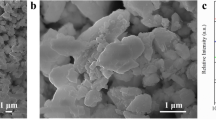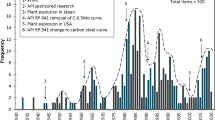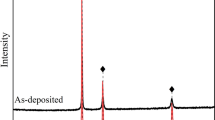Abstract
1,1-bis(tert-butylperoxy)-3,3,5-trimethylcyclohexane (TMCH), like many organic peroxides (OPs), is generally employed as a polymerization initiator and is also used comprehensively in the manufacturing process. There are two peroxy groups (–O–O–) in TMCH’s structure, so the entropy of TMCH is relatively higher than other OPs. Therefore, TMCH may release enormous amounts of energy when it decomposes and may cause serious accidents, including runaway reaction, fire, explosion, and toxic release. The aim of this study was to appraise the thermokinetic parameters of TMCH, such as heat of decomposition (ΔH d), exothermic onset temperature (T 0), maximum pressure and temperature ( P max and T max ), and other safety parameters by vent sizing package 2 (VSP2) and differential scanning calorimetry (DSC). ΔH d of TMCH is detected by DSC averaging 1103 J g−1, and apparent activation energy (E a) of different mass% of TMCH, such as 20, 25, and 30 mass%, were evaluated as 154.45, 150.07, and 142.98 kJ mol−1, respectively. Furthermore, we applied a novel advanced kinetics software to simulate the thermokinetic parameters of TMCH. According to this study, we can not only grasp the thermal properties and runaway reaction of TMCH, but also build up a safer process design to prevent and mitigate the runaway reaction.











Similar content being viewed by others
Abbreviations
- A :
-
Frequency factor (s−1 M1−n)
- dα dt −1 :
-
Conversion rate (dimensionless)
- dT dt −1 :
-
Self-heating rate, reaction rate (°C min−1)
- dP dt −1 :
-
Pressure rise rate (psig min−1)
- \( ( {\text{dT}}\,{\text{dt}}^{ - 1} )_{ \hbox{max} } \) :
-
Maximum self-heating rate (°C min−1)
- \( ( {\text{d}}P\,{\text{dt}}^{ - 1} )_{ \hbox{max} } \) :
-
Maximum pressure rise rate (psig min−1)
- E a :
-
Apparent activation energy (kJ mol−1)
- f(α):
-
Reaction model (dimensionless)
- ΔH d :
-
Heat of decomposition (J g−1)
- k :
-
Reaction rate constant (min−1)
- MTSR:
-
Maximum temperature reached due to the synthesis reaction (°C)
- n :
-
Reaction order (dimensionless)
- R :
-
Gas constant (8.314 J mol−1 K−1)
- P max :
-
Maximum pressure (psig)
- SADT:
-
Self-accelerating decomposition temperature (°C)
- T 0 :
-
Apparent exothermic onset temperature (°C)
- T f :
-
Final temperature (°C)
- T max :
-
Maximum temperature (°C)
- T initial :
-
Initial adiabatic decomposition temperature (°C)
- TMR:
-
Time to maximum rate (min, h, day)
- TMRad :
-
Time to maximum rate under adiabatic conditions (°C)
- α :
-
Degree of conversion (dimensionless)
- β :
-
Heating rate (°C min−1)
- Φ :
-
Thermal inertia (dimensionless)
References
Bosch CM, Velo E, Recasens F. Safe storage temperature of peroxide initiators: prediction of self-accelerated decomposition temperature based on a runaway heuristics. Chem Eng Sci. 2001;56:1451–7.
Chen WT, Chen WC, Hsueh KH, Chiu CW, Shu CM. Thermokinetic parameters analysis for 1,1-bis-(tert-butylperoxy)-3,3,5-trimethylcyclohexane at isothermal conditions for safety assessment. J Therm Anal Calorim. 2014;118:1085–94.
Chen WC, Chen WT, Wang YW, Chiu CW, Shu CM. Effects of mixing metal ions for the thermal runaway reaction of TMCH. J Therm Anal Calorim. 2014;118:1003–10.
Tseng JM, Lin CP, Huang ST, Hsu J. Kinetic and safety parameters analysis for 1,1-di-(tert-butylperoxy)-3,3,5-trimethylcyclohexane in isothermal and non-isothermal conditions. J Hazard Mater. 2011;192:1427–36.
Wang YW, Liao MS, Shu CM. Thermal hazards of a green antimicrobial peracetic acid combining DSC calorimeter with thermal analysis equations. J Therm Anal Calorim. 2015;119:2257–67.
Liu SH, Shu CM. Advanced technology of thermal decomposition for AMBN and ABVN by DSC and VSP2. J Therm Anal Calorim. 2015;121:533–540.
Tsai YT, Lin SY, Tong JW, Chen WC, Chen WT, Shu CM. Incompatible hazard investigation of a cycloaliphatic epoxy resin using green analytical method. J Therm Anal Calorim. 2015. doi:10.1007/s10973-015-4771-1.
Tong JW, Chen WC, Tsai YT, Cao Y, Chen JR, Shu CM. Incompatible reaction for (3–4–epoxycyclohexane) methyl–3′–4′–epoxycyclohexyl-carboxylate (EEC) by calorimetric technology and theoretical kinetic model. J Therm Anal Calorim. 2014;116:1445–52.
Chou HC, Chen NC, Hsu ST, Wang CH, Wu SH, Wen IJ, Shen SJ, Shu CM. Thermal hazard evaluation of tert-butyl hydroperoxide mixed with four acids using calorimetric approaches. J Therm Anal Calorim. 2014;117:851–5.
Wu SH, Shyu ML, I YP, Chi JH, Shu CM. Evaluation of runaway reaction for dicumyl peroxide in a batch reactor by DSC and VSP2. J Loss Prev Process Ind. 2009;22:721–7.
Wang YW, Duh YS, Shu CM. Evaluation of adiabatic runaway reaction and vent sizing for emergency relief from DSC calorimetry. J Therm Anal Calorim. 2006;85:225–34.
Wang YW, Shu CM, Duh YS, Kao CS. Thermal runaway hazards of cumene hydroperoxide with contaminants. Ind Eng Chem Res. 2001;40(4):1125–32.
Chi JH, Wu SH, Shu CM. Thermal explosion analysis of methyl ethyl ketone peroxide by non-isothermal and isothermal calorimetric applications. J Hazard Mater. 2009;171:1145–9.
Duh YS, Wu XH, Kao CS. Hazard ratings for organic peroxides. Process Saf Prog. 2008;27(2):89–99.
Liang YC, Jhu CY, Wu SH, Shen SJ, Shu CM. Evaluation of adiabatic runaway reaction of methyl ethyl ketone peroxide by DSC and VSP2. J Therm Anal Calorim. 2011;106:173–7.
Lin WH, Wu SH, Shiu GY, Shieh SS, Shu CM. Self-accelerating decomposition temperature (SADT) calculation of methyl ethyl ketone peroxide using an adiabatic calorimeter and model. J Therm Anal Calorim. 2009;95(2):645–51.
Tseng JM, Shu CM, Yu YC. Thermal hazard simulations for methyl ethyl ketone peroxide induced by contaminants. Korean J Chem Eng. 2005;22(6):797–802.
The United States Occupational Safety and Health Administration (OSHA). Establishment specific injury and illness data. http://osha.gov/.
Chen KY, Chen WT, Chiu CW, Wu TC, Shu CM. Thermal explosion simulation of methyl ethyl ketone peroxide in three types of vessel under the same volume by explosion models. J Therm Anal Calorim. 2011;106:235–41.
Liang YC, Jhu CY, Wu SH, Shen SJ, Shu CM. Evaluation of adiabatic runaway reaction of methyl ethyl ketone peroxide by DSC and VSP2. J Therm Anal Calorim. 2011;106:173–7.
Chou HC, Wu SH, Chiang CC, Horng JJ, Chi JH, Shu CM. Effects of stirring rate for thermal runaway reaction in cumene hydroperoxide manufacturing process using calorimetric techniques. J Therm Anal Calorim. 2011;106:243–8.
STARe Software with Solaris Operating System. Operating Instructions. Sweden: Mettler Toledo; 2004.
Maria G, Heinzle E. Kinetic system identification by using short-cut techniques in early safety assessment of chemical processes. J Loss Prev Process Ind. 1998;11:187–206.
Townsend DI, Tou JC. Thermal hazard evaluation by an accelerating rate calorimeter. Thermochim Acta. 1980;37:1–30.
Duh YS, Kao CS, Hwang HH, Lee WL. Thermal decomposition kinetics of cumene hydroperoxide. Trans Inst Chem Eng. 1998;76:271–6 (Part B).
ATKS AG (AKTS-Thermokinetics Software and AKTS-Thermal Safety Software). http://www.akts.com.
Brown ME, et al. Computational aspects of kinetic analysis. The ICTAC kinetics project data, methods and results. Thermochim Acta. 2000;355:125–43.
Maciejewski M. Computational aspects of kinetic analysis. The ICTAC kinetics project—the decomposition kinetics of calcium carbonate revisited, or some tips on survival in the kinetic minefiled. Thermochim Acta. 2000;355:145–54.
Burnham A. Computational aspects of kinetic analysis. The ICTAC kinetics project-multi-thermal-history model-fitting methods and their relation to isoconversional methods. Thermochim Acta. 2000;355:165–70.
Roduit B. Computational aspects of kinetic analysis. The ICTAC kinetics project-numerical techniques and kinetics of solid state process. Thermochim Acta. 2000;355:171–80.
Friedman HL. J Polym Sci Part C Polym Symp. 1964;6:183–95.
Material safety data sheet. Schlavenhorst 71, D-46395 Bocholt, Germany: Pergan GmbH, 2011.
Safe storage and handling of reactive materials. Center for Chemical Process Safety of the AIChE, New York, USA, 1995.
Acknowledgements
The authors are indebted to the technical information from the AKTS guide book on this study.
Author information
Authors and Affiliations
Corresponding author
Rights and permissions
About this article
Cite this article
Chen, WT., Chen, WC., You, ML. et al. Evaluation of thermal decomposition phenomenon for 1,1-bis(tert-butylperoxy)-3,3,5-trimethylcyclohexane by DSC and VSP2. J Therm Anal Calorim 122, 1125–1133 (2015). https://doi.org/10.1007/s10973-015-4985-2
Received:
Accepted:
Published:
Issue Date:
DOI: https://doi.org/10.1007/s10973-015-4985-2




